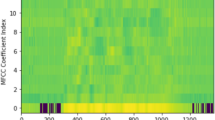Abstract
In this paper we consider the automatic emotions recognition problem, especially the case of digital audio signal processing. We consider and verify an straight forward approach in which the classification of a sound fragment is reduced to the problem of image recognition. The waveform and spectrogram are used as a visual representation of the image. The computational experiment was done based on Radvess open dataset including 8 different emotions: “neutral”, “calm”, “happy,” “sad,” “angry,” “scared”, “disgust”, “surprised”. Our best accuracy result 71% was produced by combination “melspectrogram + convolution neural network VGG-16”.
Access this chapter
Tax calculation will be finalised at checkout
Purchases are for personal use only
Similar content being viewed by others
References
Krofto, E.: Kak YAndeks raspoznaet muzyku s mikrofona. In: Yet another Conference 2013, Moscow (2013). (in Russian)
Wang, A.: An industrial strength audio search algorithm. In: ISMIR, vol. 2003, pp. 7–13 (2003)
Haitsma, J., Kalker, T.: A highly robust audio fingerprinting system with an efficient search strategy. J. New Music Res. 32(2), 211–221 (2003)
Choi, K., Fazekas, G., Sandler, M.: Automatic tagging using deep convolutional neural networks. arXiv preprint arXiv:1606.00298 (2016)
Cooley, J.W., Tukey, J.W.: An algorithm for the machine calculation of complex Fourier series. Math. Comput. 19(90), 297–301 (1965)
Ortony, A., Turner, T.J.: What’s basic about basic emotions? Psychol. Rev. 97(3), 315 (1990)
Scherer, K.R.: What are emotions? And how can they be measured? Soc. Sci. Inf. 44(4), 695–729 (2005)
Russell, J.A., Ward, L.M., Pratt, G.: Affective quality attributed to environments: a factor analytic study. Environ. Behav. 13(3), 259–288 (1981)
Livingstone, S.R., Peck, K., Russo, F.A.: Ravdess: the Ryerson audio-visual database of emotional speech and song. In: Annual Meeting of the Canadian Society for Brain, Behaviour and Cognitive Science (2012)
Simonyan, K., Zisserman, A.: Very deep convolutional networks for large-scale image recognition. arXiv preprint arXiv:1409.1556 (2014)
Busso, C., Deng, Z., Yildirim, S., Bulut, M., Lee, C.M., Kazemzadeh, A., Narayanan, S.: Analysis of emotion recognition using facial expressions, speech and multimodal information. In: Proceedings of the 6th International Conference on Multimodal Interfaces, pp. 205–211. ACM (2004)
Zhang, Z.: Feature-based facial expression recognition: sensitivity analysis and experiments with a multilayer perceptron. Int. J. Pattern Recognit. Artif. Intell. 13(06), 893–911 (1999)
Tsai, T.J., Morgan, N.: Longer features: they do a speech detector good. In: INTERSPEECH, pp. 1356–1359 (2012)
Eyben, F., Böck, S., Schuller, B.W., Graves, A.: Universal onset detection with bidirectional long short-term memory neural networks. In: ISMIR, pp. 589–594 (2010)
Ramachandran, A., Vasudevan, S., Naganathan, V.: Deep learning for music era classification. http://varshaan.github.io/Media/ml_report.pdf. Accessed 23 June 2017
Ishaq, M.: Voice activity detection and garbage modelling for a mobile automatic speech recognition application. https://aaltodoc.aalto.fi/handle/123456789/24702. Accessed 23 June 2017
Acknowledgments
The article was prepared within the framework of the Academic Fund Program at the National Research University Higher School of Economics (HSE) in 2017 (Grant №17-05-0007) and by the Russian Academic Excellence Project “5-100”.
Author information
Authors and Affiliations
Corresponding author
Editor information
Editors and Affiliations
Rights and permissions
Copyright information
© 2018 Springer International Publishing AG
About this paper
Cite this paper
Popova, A.S., Rassadin, A.G., Ponomarenko, A.A. (2018). Emotion Recognition in Sound. In: Kryzhanovsky, B., Dunin-Barkowski, W., Redko, V. (eds) Advances in Neural Computation, Machine Learning, and Cognitive Research. NEUROINFORMATICS 2017. Studies in Computational Intelligence, vol 736. Springer, Cham. https://doi.org/10.1007/978-3-319-66604-4_18
Download citation
DOI: https://doi.org/10.1007/978-3-319-66604-4_18
Published:
Publisher Name: Springer, Cham
Print ISBN: 978-3-319-66603-7
Online ISBN: 978-3-319-66604-4
eBook Packages: EngineeringEngineering (R0)




